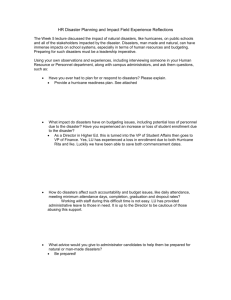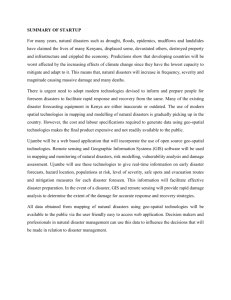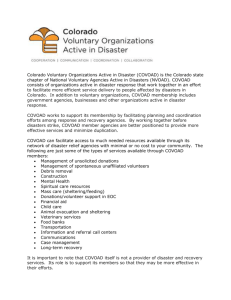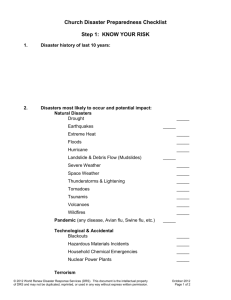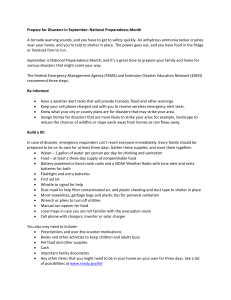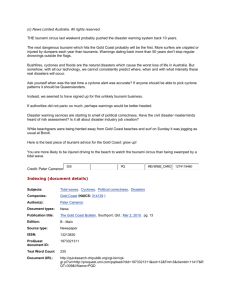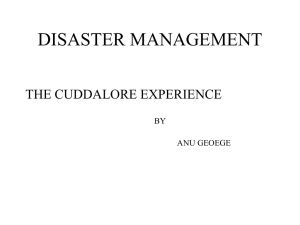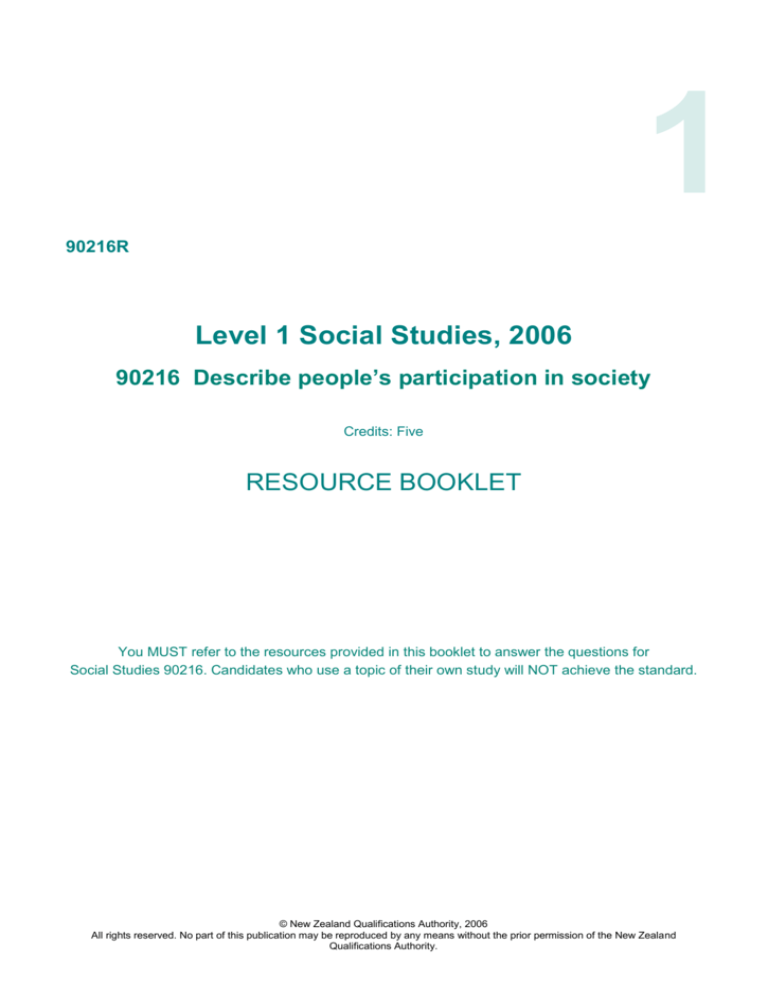
1
90216R
Level 1 Social Studies, 2006
90216 Describe people’s participation in society
Credits: Five
RESOURCE BOOKLET
You MUST refer to the resources provided in this booklet to answer the questions for
Social Studies 90216. Candidates who use a topic of their own study will NOT achieve the standard.
© New Zealand Qualifications Authority, 2006
All rights reserved. No part of this publication may be reproduced by any means without the prior permission of the New Zealand
Qualifications Authority.
RESOURCE A
(Underlined words are in glossary)
What are disasters?
Stories of disasters, both past and present and likely in the future, are constantly in the news.
The world has faced the threat of disasters throughout history.
A disaster is an event such as hurricane, tornado, snowstorm, flood, twister, tsunami,
earthquake, drought, blizzard, epidemic, famine, fire, explosion, locust plague, volcanic
eruption, building collapse, transportation accident, act of terrorism, armed conflict,
pandemic or other situation.
Disasters cause human suffering or create human needs where victims require help from
others.
Chances of survival after a disaster are greatly improved when people, local governments
and emergency services, businesses and national governments prepare evacuation plans and
gather survival gear beforehand.
Good preparation is highly dependent on the location and the type of disasters that are
likely to occur in the area.
L1 Social Studies 2006, 90216R – page 2 of 10
RESOURCE B
(Underlined words are in glossary)
Who is responsible when disasters occur?
In New Zealand, the Ministry of Civil Defence and Emergency Management (MCDEM) has
statutory authority for controlling any state of emergency declared by central government.
Local government bodies such as city and regional councils have their own emergency
management agencies to control local states of emergency, but these all support the MCDEM
in the event of a national state of emergency.
The process of emergency management involves four phases:
•
mitigation,
•
preparedness,
•
response, and
•
recovery.
Mitigation efforts attempt to prevent hazards from developing into disasters altogether, or to
reduce the effects of disasters when they occur.
In the preparedness phase, emergency managers develop plans of action for when the disaster
strikes.
The response phase includes the mobilisation of the necessary emergency services and first
responders in the disaster area, such as firefighters, police, volunteers, and nongovernmental organisations such as the Red Cross, St John Ambulance, and corporatesponsored rescue helicopters.
The aim of the recovery phase is to restore the affected area to its previous state.
Source (adapted): www.civildefence.govt.nz
L1 Social Studies 2006, 90216R – page 3 of 10
RESOURCE C
(Underlined words are in glossary)
How ready are New Zealanders for disasters?
The Consumer magazine surveyed readers on emergency-preparedness. They were surprised
to find only 37 per cent of homes surveyed had an emergency-preparedness kit. Consumer
readers are fairly well informed and were expected to be equipped to meet an emergency –
whether earthquake, flood, or even a flu epidemic.
When examined more closely, the picture became even more interesting. Wellingtonians
were the best prepared – 57 per cent said they had an emergency kit in their homes. Regular
earthquake reminders of living on the fault line obviously helps people think about
“what if ...”. But only 28 per cent of Aucklanders were prepared. Their highest risk –
dormant volcanoes – are obviously not as powerful a reminder of nature’s unpredictability.
Fortunately, emergency kits were at the top of most people’s “to-do” lists.
The New Zealand Avian (Bird Flu) Pandemic Action Plan is based on five strategic aims:
•
Plan for it
•
Keep it out
•
Stamp it out
•
Manage it, and
•
Recover from it.
The Ministry of Civil Defence and Emergency Management has a website that includes
actions people can take in preparation for disasters.
You will need to have:
•
A Household Emergency Plan
•
An Emergency Survival Kit
•
A Getaway Kit if you need to be evacuated.
Sources (adapted): http://www.consumer.org.nz
http://www.civildefence.govt.nz
L1 Social Studies 2006, 90216R – page 4 of 10
RESOURCE D (i)
(Underlined words are in glossary)
What are some New Zealand disasters?
What:
Influenza epidemic
Where:
New Zealand wide
When:
October – December 1918
Why:
At the end of the First World War, an influenza epidemic swept around the
world. The ‘Spanish flu’, as it was often called, arrived in New Zealand in early October
1918, probably with returning troops.
Effects:
The flu spread and the only way to avoid catching the virus was by keeping out
of contact with other people. There were no flu vaccinations available and no antibiotics for
those who fell ill. Between one-third and one-half of the population of New Zealand was
infected with the flu. Hospitals became full and emergency hospitals were set up in schools,
church halls, and tents. Ordinary life was impossible. Shops, offices and factories shut down
and schools, hotels and theatres were closed by order of the government. Shipping came to a
halt, many towns suffered from a shortage of basic supplies, such as flour and coal. Proper
funeral services were not held for the victims. Over 8 000 people died by the time it eased in
December. Worldwide, the flu is now thought to have killed as many as 50 million people.
Response: There was an Epidemic Commission in 1919 to investigate the cause and course
of the epidemic. Afterwards there were major changes in the health system, the most
important being the 1920 Health Act.
Future:
There is still the risk of another pandemic affecting the world. At present, the
risk of Bird Flu spreading globally is concerning governments, who are planning strategies
to cope if this occurs. New Zealand is planning for the possibility of a pandemic. The
Ministry of Health is leading pandemic planning, including national planning, risk
management and coordination of health service delivery.
Source (adapted): www.nzhistory.net.nz/culture/influenza-pandemic
L1 Social Studies 2006, 90216R – page 5 of 10
RESOURCE D (ii)
(Underlined words are in glossary)
What are some New Zealand disasters?
What:
Cyclone Bola
Where:
East Coast, North Island
When:
March 1988
Effects:
Devastating floods, winds of up to 100 kilometres per hour toppled trees and
tore off roofs. Landslides caused cuts to the power and sewage services, and closed a
number of roads. Three people died when the car they were in was swept away by
floodwaters. Te Karaka was evacuated. The State highway was closed in several places by
slips and flooding. States of emergency were declared in Wairoa, Gisborne and the East
Cape. Most of the damage happened in places where there had been little or no soil
conservation work or flood control schemes. The floods affected approximately 3 600
hectares of farming and horticultural land. Economic losses reached $90 million. Repairs to
the water supply in Gisborne cost $6.6 million, and the damage to forests on the East Coast
cost $8.6 million.
Response: A Disaster Relief Committee was set up to assess the damage caused by the
storm on the East Coast. An inquiry into flood management followed the cyclone, and made
a number of recommendations. These included soil conservation work, river control
(stop banks) and management, and land-use planning.
Future:
These measures were applied to all of New Zealand in an attempt to reduce the
impact of future floods.
Source (adapted): www.teara.govt.nz/EarthSeaAndSky/NaturalHazardsAndDisasters/Floods/4/en
L1 Social Studies 2006, 90216R – page 6 of 10
RESOURCE E
(Underlined words are in glossary)
What are the consequences of disasters?
Tsunami – 26 December 2004
Indonesia
Impact: Indonesia had the worst human losses and physical damage in the tsunami and
earthquake of 26 December 2004. The western tip of the island of Sumatra – the closest
inhabited area to the earthquake’s epicentre – was devastated. Some coastal villages are
thought to have lost more than 70% of the people living there. Much of the fishing and
agricultural sectors in Aceh province was heavily damaged and 44% of people lost their
livelihoods, according to the Asian Development Bank.
Toll:
More than 130 000 people died, while at least 37 000 others remain missing. The
exact number of victims will probably never be known. About 500 000 people were made
homeless. Thousands of documents were destroyed, so finding out who owns what land is a
problem. In some places, land has disappeared under the sea.
Aid:
After the tsunami, more than 160 aid organisations and UN agencies began
operations in Indonesia to provide food, shelter and schooling. Foreign troops were also
involved in initial emergency relief efforts. One year after the disaster, Aceh’s provincial
capital, Banda Aceh, had been completely rebuilt, but there were still areas not far away that
remained deserted wasteland. More than 60 000 survivors were still living in tents. As
former US President Bill Clinton, the United Nations’ special envoy for tsunami relief, noted
when he visited Aceh: “We shouldn’t rest on our laurels, but things are moving in the right
direction.”
Maldives
Impact: The extremely low-lying Maldives consist of 199 inhabited islands, 20 of which
were described as “totally destroyed” by the tsunami. Well over 4 000 homes were destroyed
or damaged. Schools, boats, infrastructure and tourist resorts also suffered.
Toll:
At least 81 people died. The impact on the country’s economy was huge.
Aid:
The Maldives government put rebuilding costs for homes and infrastructure at
about $375 million.
Thailand
Impact: The west coast of Thailand was severely hit, including outlying islands and
tourist resorts near Phuket.
Toll:
Some 5 395 people were confirmed dead. They included about 2 400 foreigners
from 36 countries. The number of people still missing exceeds 2 800. Some bodies may still
lie in the rubble of wrecked hotels.
L1 Social Studies 2006, 90216R – page 7 of 10
Aid:
Thailand did not ask for disaster relief aid, but it requested technical help to
identify the dead. However, more than 3 500 volunteers from more than 50 countries
volunteered their services to help Thailand recover. Rebuilding has been very quick along
Thailand’s west coast, which is heavily dependent on tourism. The United Nations has
praised the Thai government’s response, and notes that tourism development is happening.
The UN’s report found that the fishing industry suffered far greater losses than the tourism
industry – about $267.8 million.
The Thai government provided more than $1 billion in aid, while international aid totalled
$69 million.
Source (adapted): http://news.bbc.co.uk
L1 Social Studies 2006, 90216R – page 8 of 10
RESOURCE F
(Underlined words are in glossary)
What are people’s perceptions of disasters?
These people have perceptions on disasters that they have experienced.
Habibullah Bahar, a community organiser in Bangladesh, where floods are a regular
occurrence, perceives that: “Today the situation here is much better than it was ten years
ago. The preparations people make for floods are much more organised than before. We will
always have floods. But we can minimise their effects.”
Beddie Jubilee, a local woman from Papua New Guinea, commented on the response to the
1994 Rabaul volcanic eruption, where only five people were killed: “People organised
themselves, knowing the signs and knowing the stories told by their forefathers of the 1937
eruption.”
Mr Lewis, who experienced the 1931 Napier earthquake, said: “All of a sudden the car
shook violently. I jumped out to see what was wrong, but fell over. On looking up I saw all
the buildings opposite collapsing … People were rushing about screaming … Every twostorey brick building came down. All the asphalt roads buckled up. People were lying dead
in the streets. Women rushed about in hysterical condition, while thousands, on reaching the
beach, entered the water.”
A locust expert from Mauritania said, after a locust invasion in 2004: “There will be no
millet, no sorghum, no beans and no peanuts in Mauritania. Animals will also be out of
food, as there is no pasture, no trees for camels and goats, and no hay for cows and sheep.”
Davis Mulomba, Malawian farmer, commented in September 2005: “We tried to believe in
our hearts that we’d harvest something … that the rains would start again, but the dry spell
continued and there was no rain.”
Source (adapted): Global Issues, May 2006
L1 Social Studies 2006, 90216R – page 9 of 10
GLOSSARY
aid:
money and help given by other countries to a country that has experienced a
disaster – sometimes aid can be in the form of help and assistance
epidemic:
spreading quickly and widely by infection and affecting many individuals in an
area or a population at the same time
evacuation plan:
a plan that says how people will get out of a building or area in a disaster
locust:
a type of grasshopper that eats and destroys crops
mobilisation:
the act of gathering together and getting ready for a disaster
pandemic:
a disease epidemic, which spreads across the whole of a country or the whole
of the world and affects many people
perception:
a person’s viewpoint or idea about something
state of emergency: a time and place when a disaster is impacting on people and they need help
statutory authority:
the organisation that is legally ‘in charge’
sorghum:
a type of grass that is grown as a crop
stop bank:
a man-made bank near a river or the ocean that is built to stop rising water
and flooding
survival:
the act or process of surviving
volunteer:
a person who helps or does a job in their own time without payment
L1 Social Studies 2006, 90216R – page 10 of 10

